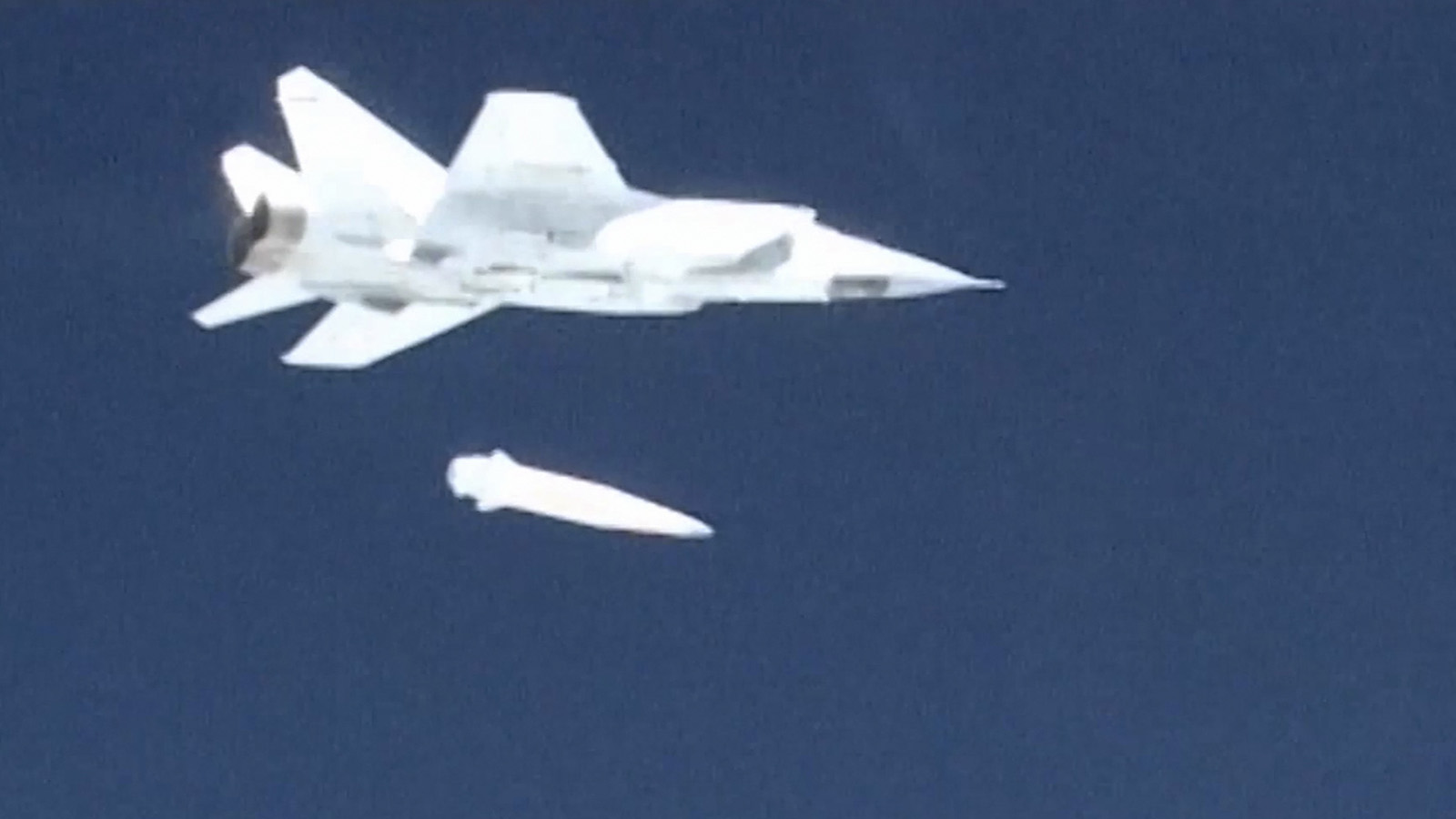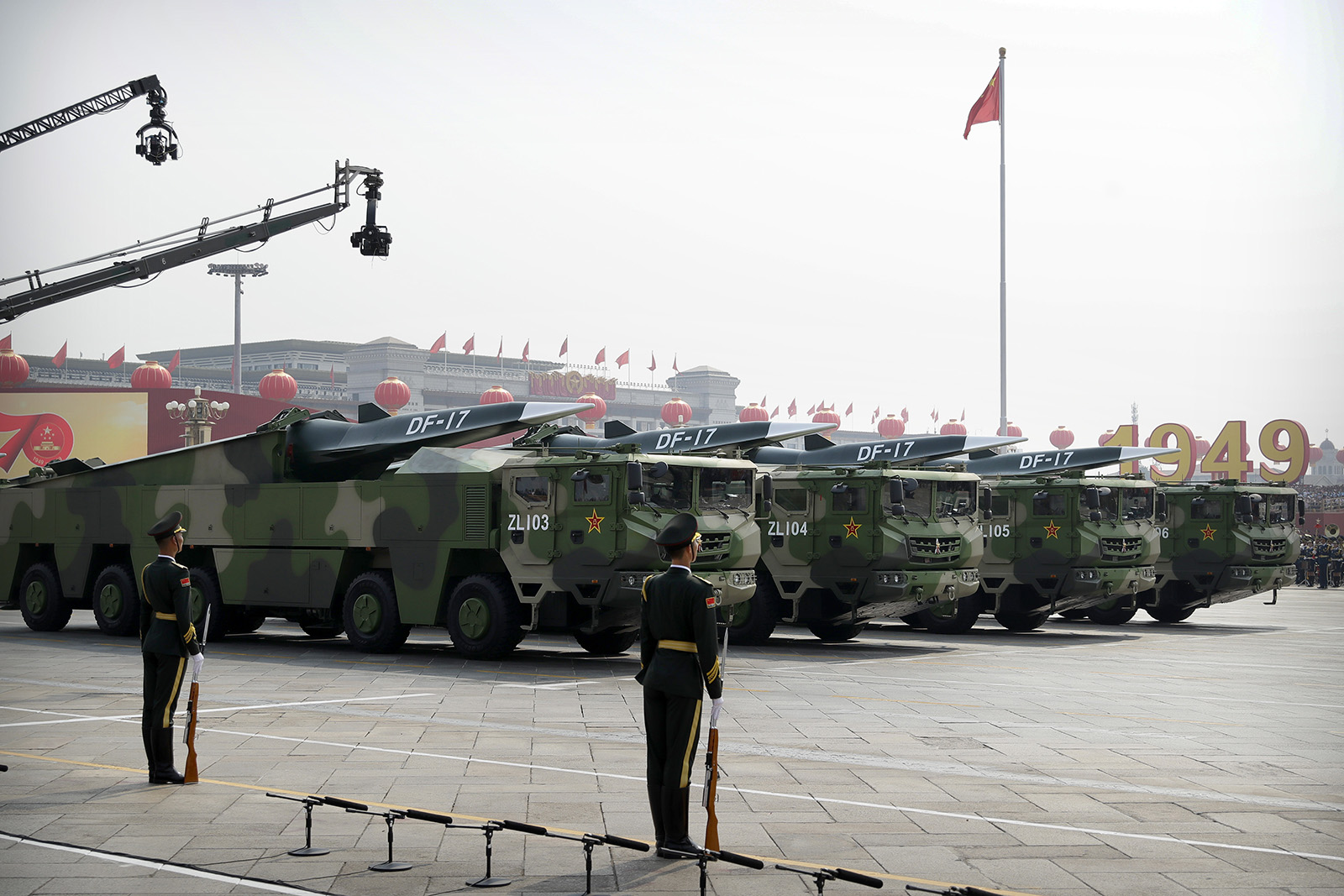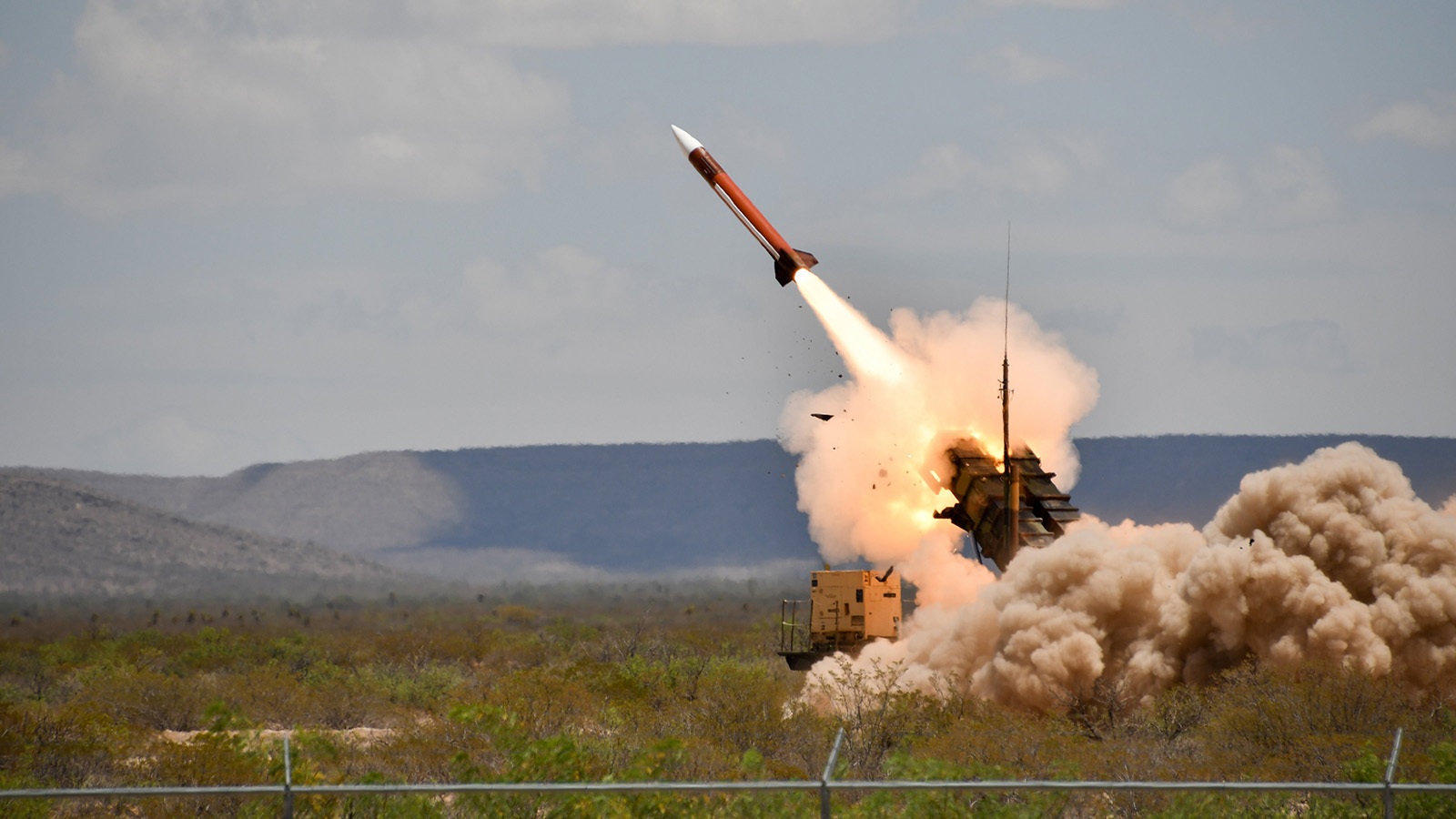Stay Up to Date
Submit your email address to receive the latest industry and Aerospace America news.
Hypersonic glide vehicles and air-breathing versions of these weapons have prompted two U.S. administrations to pump billions of dollars into better radars and space instruments for tracking them so they can be targeted effectively. Mike Gruss sorts the myth from the reality of the threat.
A hypersonic weapon had rarely been made to sound so frightening.
“Its speed makes it invulnerable to current missile and air defense systems, since interceptor missiles are, simply put, not fast enough,” Russian President Vladimir Putin said during his 2018 state of the nation address, according to a translation. “It is quite understandable why the leading armies of the world seek to possess such an ideal weapon.”
Then came the rhetorical flourish: “Friends,” he said to government leaders at the Manezh Central Exhibition Hall in Moscow, “Russia already has such a weapon.”
This weapon could fly 10 times faster than the speed of sound and maneuver at any time, which “allows it to overcome all existing and, I think, prospective anti-aircraft and anti-missile defense systems.”
On the screens on either side of Putin, a video unveiled the Kh-47, or Kinzhal, which translates to dagger. Its first operational use came in March 2022, when an unspecified number were fired into southwestern Ukraine, destroying a weapons depot. But that incident was before Ukraine received its first Patriot battery in April 2023, an air defense system typically consisting of a radar, truck-mounted missile interceptors, and a command and control station staffed by three. Russia tried again that May, releasing a Kinzhal from a MiG-31K fighter over Kyiv, but this time the Kinzhal was destroyed by a Patriot interceptor, a Ukraine Air Force official announced.

A weapon system whose core technology was developed 40 years ago had destroyed a hypersonic weapon that Putin had claimed would prove to invincible. In the years since, other Kinzhals have gotten through and others have reportedly been shot down, signaling that the Kinzhals are dangerous but not impervious. Given that result, it’s natural to wonder if China’s hypersonic weapons could also prove to be vulnerable to existing defenses.
Mark Lewis, who led the Pentagon’s hypersonic research efforts from 2019 to 2021, cautions against such a leap.
“The most important thing we learned from that is the Russians build really crappy weapons,” says Lewis, now the chief executive of Purdue University’s Applied Research Institute. “A lot of it is legacy technology from the Cold War era. They’re barely hypersonic. I won’t go into details, but they’ve made some really bad engineering decisions.”
A popular view in the Pentagon is that Kinzhal should be viewed as a small ballistic missile that’s fired from the air and has limited maneuverability. While it does fly hypersonically, it does not merit the “hypersonic weapon” label that U.S. planners have adopted as shorthand for the budding class of highly maneuverable weapons that streak toward targets at speeds far above Mach 5.
“China is a whole different story from Russia. We know the Chinese have made a big point about the fact that they have built hypersonic weapons, that they display them,” Lewis says.
During a 2019 parade in Beijing, China showed off the DF-17 missiles that carry its DF-ZF hypersonic glide vehicles — those that are boosted to hypersonic speeds and released. A 2023 Pentagon report to Congress noted that in July 2021, China had its “first fractional orbital launch of an ICBM [intercontinental ballistic missile] with a hypersonic glide vehicle from China. This demonstrated the greatest distance flown (~40,000 kilometers) and longest flight time (~100+ minutes) of any Chinese land attack weapons system to date.”

With such saber-rattling, a vigorous refocusing of U.S. missile defense strategy to defend against such weapons and air-breathing versions has continued largely intact through the Biden administration after a ramp-up during Lewis’ years in the Pentagon. The U.S. Navy is deeply involved, given that the U.S. has cited the vulnerability of carrier groups like those that would have to help defend Taiwan from a Chinese invasion. China and Russia often depict hypersonic weapons targeting carriers in videos, including the one Putin showed in 2018 when announcing the Kinzhal.
Lewis boils down hypersonic missile defense to essentially three problems: identifying the vehicle, tracking where it’s going and being able to hit the weapon at the right moment. The majority of hypersonic defense spending in the U.S. goes toward the first two problems. To that end, the Space Force, Missile Defense Agency and Space Development Agency are paying contractors to develop satellites that, together with radars, should make it difficult for a hypersonic weapon to hide. From there, tracking would be handed off to a kill vehicle. In September, the Missile Defense Agency announced Northrop Grumman would design and build the Glide Phase Interceptor to do just that.
There is one phenomenon that helps give away such weapons: “When a hypersonic aerial vehicle is traveling through the atmosphere at speeds of Mach 5 or higher, it encounters intense friction with the surrounding air,” officials from the Naval Air Systems Command wrote in 2023 acquisition documents. “The nose cone and the leading edges of the flight vehicle will experience extremely high temperatures up to 3000-5000 degrees Fahrenheit.”
How could that vulnerability be tapped to track and target these weapons? The answer traces in part to 1970, when the U.S. military began launching satellites equipped with infrared telescopes to geostationary positions high over the equator. The main concern then, and for the next three decades, was to detect any launches of nuclear-armed intercontinental ballistic missiles. Under the deterrence doctrine of mutually assured destruction, the Soviets and later the Russians could count on the U.S. to retaliate, and that’s how the peace was kept. With the exception of the Reagan administration’s short-lived initiative to shoot down missiles and warheads from space, tracking the weapons as they streaked to their targets was less of a concern.
Then the Soviet Union dissolved, and the U.S. withdrew from the 1972 Anti-Ballistic Missile Treaty in 2002. Anti-missile rockets in silos were positioned in Alaska and California to defend against North Korean missiles.
Tracking became more of a concern, even as the U.S. began launching the current iteration of missile warning satellites in 2011, the Space-Based Infrared System, now consisting of six satellites in GEO and also four in a highly elliptical polar orbit.
SBIRS was designed mainly for detecting the launch of a missile, not tracking it or its warheads. So in 2009, the Missile Defense Agency launched two experimental satellites into low-Earth orbit, known as the Space Tracking and Surveillance System, to follow those weapons along their path.
The emergence of Chinese hypersonic weapons the last decade snapped the Pentagon and Congress into heightened action in 2018. Part of the response came in the form of the Hypersonic and Ballistic Tracking Space Sensor satellites, a joint project between the Space Development Agency and the Missile Defense Agency that is part of SDA’s planned Proliferated Warfighter Space Architecture constellation. The first two HBTSS prototypes — one built by L3Harris and the other by Northrop Grumman — were launched together in February to LEO. In June, the Missile Defense Agency announced that the HBTSS satellites logged their first views of a hypersonic craft when they tracked a Kratos-built hypersonic test vehicle after its launch from Wallops Island in Virginia.
The Space Force is also bolstering tracking from GEO. Thus far, it has awarded Lockheed Martin $8.2 billion to develop and test two satellites as part of the Next-Generation Overhead Persistent Infrared program. The first satellite is targeted for launch in 2026, and will be equipped with infrared cameras that RTX is developing. The program will also include two satellites in polar orbit. Northrop Grumman was awarded $4.1 billion for those polar satellites, with BAE Systems developing the infrared payloads.
The reason for all the additional infrared eyes in the sky is this: A hypersonic weapon separates from its booster at a lower altitude than, for example, the warheads of a ballistic missile. As the weapon glides, it can’t be easily seen from GEO because the satellite is looking straight down on the weapon against Earth as the background. By contrast, a ballistic missile often ascends to the fringes of space to release its warheads, and satellites can look off toward the curve of the Earth and see those weapon against the cold of space.
Tracking a hypersonic weapon is a different matter. It means seeing one hot object against a background that has lots of infrared emitters in it in the form of cities, highways and aircraft. The classic analogy refers to detecting “a slightly brighter candle in a sea of candles,” analyst Masao Dahlgren at the Center for Strategic and International Studies wrote in a 2023 report, “Getting on Track: Space and Airborne Sensors for Hypersonic Missile Defense.”
The Defense Department’s newest satellites, the HBTSS spacecraft, would orbit in LEO at about 1,000 kilometers compared to 36,000 km in GEO. This doesn’t mean they would be able to see the hypersonic weapons against the cold of space, but LEO would put them closer to these targets for improved resolution, or perhaps equivalent resolution with smaller sensors. Finer resolution might be necessary, since a hypersonic glide vehicle may take up less than 0.1% of an image area, according to a 2023 paper from Yee Wei Law at the University of South Australia, meaning it’s hard to see and hard to find quickly. HBTSS is also part of the Pentagon’s strategy to increase the number of satellites, the thinking being that “proliferated” constellations will be harder for an adversary to blind.
Tracking hypersonic weapons with radar can also be troublesome. “When an aerial vehicle is traveling at hypersonic speed through the atmosphere, a plasma sheath envelops the aerial vehicle because of the ionization and dissociation of the atmosphere surrounding the vehicle,” the Navy said in another small business research solicitation. “The plasma sheath absorbs radio waves,” which makes the vehicle “practically invisible to active radar systems.”
A goal is to make those moments of invisibility more rare. One company working toward that is Orion Space Solutions, a small company of about 100 people near Louisville, Colorado. Engineers and scientists there have been experimenting with ground radars that track changes to the ionosphere — the region of the atmosphere that starts at 80 km — when a missile or vehicle streaks through it.
Chad Fish, the company’s president and general manager, explains it this way: Think of a boat traveling through water. The boat leaves a wake, a pattern that can show which way the vessel is headed, its velocity and its size. The ionosphere works the same way, and waves from hypersonic vehicles can be detected by radar.
Orion is working with a government agency (Fish declined to say which one) to deploy and operate the radars and also determine what kinds of data are most helpful. In the past, Fish says, the company has identified the signatures of launch vehicles on their way to orbit. “We anticipate and expect that we can then track hypersonics during midcourse.”
Once a hypersonic glider, for example, descends to lower than about 60 km, it’s almost in the seams of space-based and ground-based radars. The tracking would need to be handed off to another radar or satellite to transmit data, or to a fire control network where an operator would approve the launch of an interceptor missile.

And so, the Kinzhal attacks in Ukraine have been a learning experience — but for U.S. defense officials, not one that should amount to a deflating of the hypersonic threat.
While Ukraine shows that at least some hypersonic weapons can be stopped, it also suggests that a perfect defense might not be attainable. A Ukrainian government official seemed to acknowledge this reality in early October: The area around a major Ukrainian air base had been struck. The military had shot down two Kinzhals, but a third had gotten through the defenses.
About Mike Gruss
Mike freelances from northern Virginia. Previously, he was editor-in-chief of Sightline Media Group, where he led publications including Defense News and Military Times, and was the military reporter at SpaceNews.
Related Posts
Stay Up to Date
Submit your email address to receive the latest industry and Aerospace America news.




